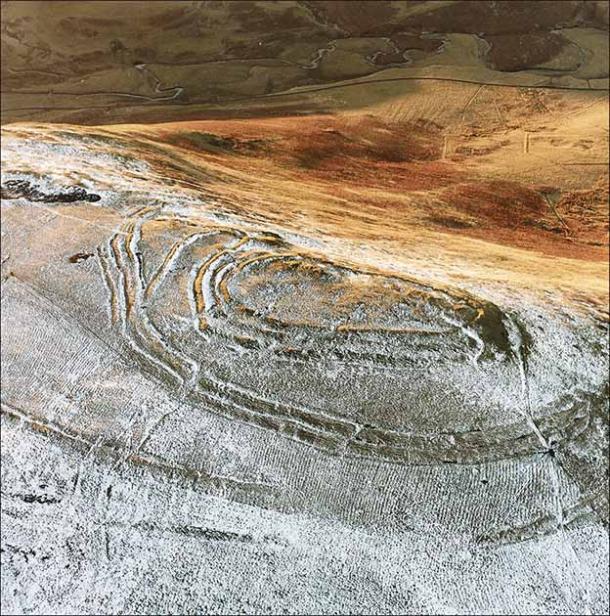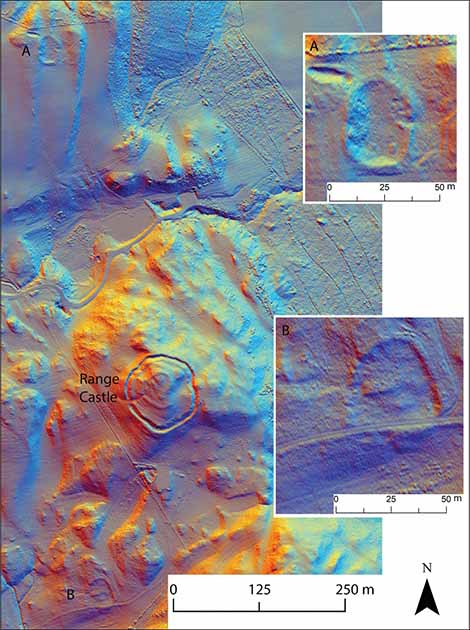
Over 100 Indigenous Settlements North of Hadrian’s Wall Discovered
Northern Britain, a fluctuating frontier area during the Roman occupation of Britain (43-410 AD), represented a tussle between Iron Age communities and the centralizing authority and power of the Roman state. A fascinating new paper published in the prestigious journal Antiquity has surveyed the area north of Hadrian’s Wall, and identified over a 100 previously undiscovered indigenous settlements, dated to the time of the Roman occupation. This is a breakthrough s tudy, since the vast majority of archaeological attention has long been focused on the Romans in the region as opposed to the indigenous inhabitants the Empire sought to control.
Forget the Romans! Indigenous Hadrian’s Wall Settlements
Hadrian was the emperor of the Roman Empire from 117 to 138 AD. Halfway into his reign, in 122 AD, work had begun on his eponymous wall. It was meant to represent the northernmost border of the Empire, which it was, for about 20 years. Incidentally, northern England and southern Scotland are one of the few areas in Western Europe where the Romans could not establish full-fledged control.
From the safety and security of Hadrian’s Wall, the Romans expanded further north and built Vallum Antonini or the Antonine Wall, as the newest northernmost Roman frontier. Construction began in 142 AD under the command of Antonius Pius, and took 12 years to complete (unlike Hadrian, Pius never visited Britannia). Just 8 years after its completion, in 162 AD, the wall was abandoned, and the frontier line was Hadrian’s Wall again.
Dr. Manuel Fernández-Götz, head of archaeology at the University of Edinburgh, lead author on the study said:
“This is one of the most exciting regions of the Empire, as it represented its northernmost frontier, and also because Scotland was one of very few areas in Western Europe over which the Roman army never managed to establish full control.”

An example of indigenous Hadrian’s Wall settlements, this complex earthworks at Woden Law hillfort in southern Scotland lie close to a Roman road, with Roman camps less than 2 kilometers (1.24 miles) away. (© Crown copyright: Historic Environment Scotland / Antiquity Publications Ltd).
Most research, until now, had focused on the region between the two walls and studied the Roman perspective, Roman forts, camps, roads, and walls, which was a decidedly top-down approach. Dr. Fernández-Götz and his team set out to purposefully study the indigenous communities living in this frontier region, virtually for the first time ever.
Finding The Locals’ Settlements From Max Roman War Evidence
To subvert the dominant narrative and historiography surrounding Roman occupation, the new Leverhulme-funded project titled “ Beyond Walls: Reassessing Iron Age and Roman Encounters in Northern Britain” (2021–2024) seeks a new approach. The project has a long-term perspective built on the landscape-based approach, covering the period from circa 500 BC-500 AD. The first pilot test for this approach was taken in the area around Burnswark Hillfort using Lidar drones.
Burnswark Hillfort is part of the project’s overall area of study that encompasses the area between Durham and the southern Scottish Highlands. The reason for choosing this part of Roman Britain is because it boasts the highest concentration of Roman projectiles in the entire region. A report by Archaeology UK in 2016 mentions how “Burnswark is witness to a greater number and variety of Roman projectiles on a native site than anywhere else in Britain.” This is clear evidence of the devastating power of Roman legions, who mercilessly assaulted any indigenous tribe or group that attempted to halt their expansion.
An area of 1,500 square kilometers (579 square miles) was explored in the area beyond Burnswark using LiDAR (Light Detection and Ranging) drones, which is essentially 3-D laser scanning. The support of the British academy was enlisted, helping reveal a total of 134 indigenous Iron Age “Hadrian’s Wall settlements” in the region, which had not been recorded before. Researchers believe at least 700 such settlements lay hidden beneath the project’s study area.

Lidar image revealing two newly identified indigenous settlement enclosures (A and B) in the vicinity of the well-known Range Castle fort. (Fernández-Götz et al. / Antiquity Publications Ltd).
“The important thing about the discovery of many previously unknown sites is that they help us to reconstruct settlement patterns,” said co-investigator Dr. Cowley, from Historic Environment Scotland. “Individually they are very much routine, but cumulatively they help us understand the landscape within which the indigenous population lived,” he added.
- 1000 Ancient Sites Revealed by Aerial Scan of Scotland’s Arran Island
- Illegal Metal Detectorists Cause Irreparable Damage to 1900-Year-Old Hadrian’s Wall
The research results indicate a dense distribution of highly-organized settlement sites dispersed across the region. Small farmsteads were the norm for the majority of these indigenous settlers. And scientists will also apply radiocarbon dating testing on what lays beneath the soil at these settlement locations. This will help in establishing elements of continuity and long-term development, allowing for a more nuanced understanding of the indigenous peoples of this frontier region, who stopped the Romans from going further north. At the same time, this landscape-based research approach is providing us with a more complex view of Iron Age Britain including the Romans and the local indigenous settlers.
Top image: Burnswark hillfort in southwest Scotland was used as the start point for discovering the indigenous Hadrian’s Wall settlements, which lay north of Hadrian’s Wall that was pretty much the northernmost frontier of the Roman Empire. Source: J. Reid / Antiquity Publications Ltd
By Sahir Pandey
References
Gotz-Fernandez, M., Cowley, D., et al. 2022. Beyond Walls: Reassessing Iron Age and Roman Encounters in Northern Britain. Antiquity, 96 (388). Available at: https://doi.org/10.15184/aqy.2022.47.















